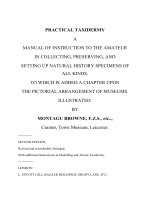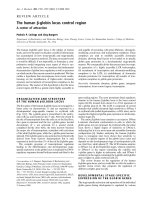A Manual of the Operations of Surgery potx
Bạn đang xem bản rút gọn của tài liệu. Xem và tải ngay bản đầy đủ của tài liệu tại đây (648.2 KB, 185 trang )
CHAPTER I.
CHAPTER II.
CHAPTER III.
CHAPTER IV.
CHAPTER V.
CHAPTER VI.
CHAPTER VII.
CHAPTER VIII.
CHAPTER IX.
CHAPTER X.
CHAPTER XI.
CHAPTER XII.
CHAPTER XIII.
CHAPTER XIV.
CHAPTER I.
CHAPTER II.
CHAPTER III.
CHAPTER IV.
CHAPTER V.
CHAPTER VI.
CHAPTER VII.
CHAPTER VIII.
CHAPTER IX.
CHAPTER X.
CHAPTER XI.
CHAPTER XII.
CHAPTER XIII.
CHAPTER XIV.
1
A Manual of the Operations of Surgery, by
Joseph Bell
This eBook is for the use of anyone anywhere at no cost and with almost no restrictions whatsoever. You may
copy it, give it away or re-use it under the terms of the Project Gutenberg License included with this eBook or
online at www.gutenberg.org
Title: A Manual of the Operations of Surgery For the Use of Senior Students, House Surgeons, and Junior
Practitioners
Author: Joseph Bell
Release Date: February 11, 2008 [eBook #24564]
Language: English
Character set encoding: ISO-8859-1
***START OF THE PROJECT GUTENBERG EBOOK A MANUAL OF THE OPERATIONS OF
SURGERY***
E-text prepared by Michael Ciesielski, Pilar Somoza Fernández, and the Project Gutenberg Online Distributed
Proofreading Team ()
Note: Project Gutenberg also has an HTML version of this file which includes the original illustrations. See
24564-h.htm or 24564-h.zip: ( or
( />Transcriber's note:
Spelling mistakes have been left in the text to match the original, except for obvious typographical errors.
A MANUAL OF THE OPERATIONS OF SURGERY
For the Use of Senior Students, House Surgeons, and Junior Practitioners.
Illustrated.
by
JOSEPH BELL, F.R.C.S. EDIN.
Lecturer on Clinical Surgery, Surgeon to the Royal Infirmary and to the Eye Infirmary, and Late
Demonstrator of Anatomy in the University of Edinburgh.
FIFTH EDITION, REVISED AND ENLARGED.
Edinburgh: Maclachlan & Stewart, Booksellers to the University. London: Simpkin, Marshall, & Co. 1883.
A Manual of the Operations of Surgery, by 2
TO THE MEMORY OF JAMES SYME, ESQ., F.R.C.S. AND F.R.S.E. SURGEON TO THE QUEEN IN
SCOTLAND
PROFESSOR OF CLINICAL SURGERY IN THE UNIVERSITY OF EDINBURGH ETC. ETC.
THIS BOOK IS DEDICATED BY HIS OLD HOUSE-SURGEON AND ASSISTANT
THE AUTHOR.
PREFACE TO FIFTH EDITION.
To retain the small size of the work and to keep it up to date have been the Author's aim in the Fifth Edition.
20 MELVILLE STREET, EDINBURGH, August 1883.
PREFACE TO THE FIRST EDITION.
Having been asked, year after year, by the members of my Class for Operative Surgery, to recommend to
them some Manual of Surgical Operations which might at once guide them in their choice of operations, and
give minute details as to the mode of performance, I have been gradually led to undertake the production of
this little work.
My aim has been to describe as simply as possible those operations which are most likely to prove useful, and
especially those which, from their nature, admit of being practised on the dead body.
In accordance with this plan, neither historical completeness of detail, nor much variety in the methods of
performing any given operation, is to be expected. Hence, also, many omissions which would be
unpardonable in the briefest system of Surgery are unavoidable. For example, excision of tumours and
operations for necrosis are hardly mentioned, because for these no special instructions can well be given; for,
while general principles may guide us to what should be done, the special circumstances of each case must
dictate how it is to be done.
In such a work as this, to attempt originality would be undesirable and intrusive; a judicious selection, a
faithful compilation, are all that can be expected.
That the selection of operations may sometimes show "Northern Proclivities" is possible; and this is perhaps
not unnatural to a scholar and teacher in the Edinburgh School.
An earnest endeavour has been used to make the references correct and copious: for any mistakes or
omissions the author would crave indulgence.
The four plates which precede the letterpress were drawn on wood (from original photographs) by Mr. D.W.
Williamson, Melbourne Place, and the lines of incision for the various operations were added by the author.
The rough woodcuts scattered through the work were drawn on wood by the author, and for their roughness
he, not his engraver, is responsible. He also hopes that the references in the letterpress will be accepted as
sufficient acknowledgment of the true ownership, in those few instances in which the idea of the diagram has
been borrowed.
It has been thought unnecessary to introduce woodcuts of surgical instruments, as the illustrated catalogues
lately published by Weiss, Maw, and others, are sufficiently accurate.
A Manual of the Operations of Surgery, by 3
In excuse of the frequent baldness and brevity of the style, the author must point to the size and price of the
work. Its composition would have been easier had its dimensions been greater.
Though intended chiefly to guide the studies, on the dead subject, of students and junior practitioners, the
author ventures to hope that the Manual may be useful to those who, in the public services, in the colonies, or
in lonely country districts, find themselves constrained to attempt the performance of operations which, in the
towns, usually fall to the lot of a few Hospital Surgeons.
JOSEPH BELL.
5 CASTLE TERRACE, EDINBURGH, July 1866.
CONTENTS.
A Manual of the Operations of Surgery, by 4
CHAPTER I.
LIGATURE OF ARTERIES.
PAGE
Ligature of Arteries General Maxims Ligature of
Aorta Iliacs Gluteal Femoral Popliteal Innominate Carotids Lingual Subclavian Brachial, etc., 1-45
CHAPTER I. 5
CHAPTER II.
AMPUTATIONS.
Eras of Amputation Flap and Circular compared Special Amputation of Arm and Leg, 46-107
CHAPTER II. 6
CHAPTER III.
EXCISION OF JOINTS.
Brief Historical Sketch Comparison of Excisions with Amputations Special Excisions of the six larger
Joints Excisions of smaller Joints and Bones, 108-146
CHAPTER III. 7
CHAPTER IV.
OPERATIONS ON CRANIUM AND SCALP.
Trephining Excision of Wens, 147-150
CHAPTER IV. 8
CHAPTER V.
OPERATIONS ON THE EYE AND ITS APPENDAGES.
Entropium and Ectropium Trichiasis Tarsal Tumours On Lachrymal Organs Mr. Bowman's
Operation Pterygium Strabismus, convergent and divergent Paracentesis of the Anterior
Chamber Operations for Cataract by Displacement, Solution, and Extraction Various methods of
Extraction Operations for Artificial Pupil Iridesis Corelysis Iridectomy Excision of
Staphyloma Excision of Eyeball, 151-174
CHAPTER V. 9
CHAPTER VI.
OPERATIONS ON THE NOSE AND LIPS.
Rhinoplastic Operations from Cheek, Forehead, and elsewhere Removal of Nasal Polypi Excision of
Cancers of Lips Cheiloplastic Operations Operations for Harelip, 175-187
CHAPTER VI. 10
CHAPTER VII.
OPERATIONS ON THE JAWS.
Excision of Upper Jaw Of Lower Jaw, 188-195
CHAPTER VII. 11
CHAPTER VIII.
OPERATIONS ON MOUTH AND THROAT.
For Salivary Fistula Excision of Tongue, complete and partial Fissures of the Palate, soft and hard Excision
of Tonsils, 196-205
CHAPTER VIII. 12
CHAPTER IX.
OPERATIONS ON AIR PASSAGES.
Larynx and Trachea Tracheotomy Tubes Laryngotomy OEsophagotomy [see Addendum, p. 302],
206-217
CHAPTER IX. 13
CHAPTER X.
OPERATIONS ON THORAX. PAGE Excision of Mamma Paracentesis Thoracis, 218-221
CHAPTER X. 14
CHAPTER XI.
OPERATIONS ON ABDOMEN.
Paracentesis Abdominis Gastrotomy Ovariotomy Operation for Strangulated
Hernia Inguinal Femoral Umbilical Operations for the Radical Cure of Hernia, 222-255
CHAPTER XI. 15
CHAPTER XII.
OPERATIONS ON PELVIS.
Lithotomy Varieties Lithotrity Operations for Stricture Puncture of the Bladder Phymosis Amputation
of Penis Hydrocele Hæmatocele Castration Operation for Fistula Fissure Polypi of Rectum Piles,
256-295
CHAPTER XII. 16
CHAPTER XIII.
TENOTOMY.
On Tenotomy for Wry Neck and Club Foot, 296-298
CHAPTER XIII. 17
CHAPTER XIV.
OPERATIONS ON NERVES.
Nerve-stretching Nerve-cutting Nerve suture, 299-301
ADDENDUM to Chapter IX., 302
INDEX, 303-311
LIST OF ILLUSTRATIONS.
FIG. PAGE
I. Amputations of Fingers, 50
II. Diagram of Finger showing Articulations, 50
III. Dubrueil's Amputation at Wrist (front view), 57
IV. " " (dorsal view), 57
V. Amputations of Toes, 69
VI. Excision of Wrist-joint Lister's, 126
VII. Operations for Ectropium and Entropium, 151
VIII. Operation for Trichiasis Streatfeild's, 151
IX. Operation for Epiphora Bowman's, 155
X. Greenslade's Instrument for above, 156
XI. Operations for Squint, 157
XII. Linear Extraction of Cataract, 162
XIII. Flap Extraction of Cataract, 162
XIV. Operation of Corelysis Streatfeild's, 171
XV. Operation for Staphyloma Critchett's, 172
XVI. Result of above, 172
XVII. Rhinoplastic Operation from Cheek, 176
XVIII. " " Forehead, 177
XIX. Operation on Lip, V-shaped incision, 181
CHAPTER XIV. 18
XX. Operation on Lip, by scissors, 181
XXI. Operation for a new Lip, incisions, 182
XXII. Operation for New Lip sewed up, 182
XXIII. Diagram of Partial Fissure (Harelip), 184
XXIV. Nelaton's Operation for ditto, 184
XXV. Operation for Double Harelip, 185
XXVI. Diagram of Double Harelip, 186
XXVII. Excision of Upper and Lower Jaws, 189
XXVIII. Operation for Salivary Fistula, 196
XXIX. Operation for Fissure in Soft Palate, 201
XXX. Operation for Fissure in Hard Palate, 203
XXXI. Diagram illustrating Operations on Air Passages, 207
XXXII. Diagram illustrating Operations for Hernia, 241
XXXIII. Diagram of an Artificial Anus, 253
XXXIV. Diagram of Section of Prostate, 257
XXXV. Diagram of Membranous portion of Urethra, 259
XXXVI. Diagram illustrating Puncture of Bladder, 284
XXXVII. Diagram of Operation for Phymosis, 286
XXXVIII. Diagram of Amputation of Penis, 287
[Illustration]
PLATE I.
1. Ligature of Aorta Sir A. Cooper's incision.
2. Ligature of Aorta South and Murray's incision.
3. Ligature of Common Iliac.
4. Ligature of External Iliac Sir A. Cooper's.
5. Ligature of Femoral in Scarpa's triangle.
CHAPTER XIV. 19
6. Ligature of Femoral below Sartorius.[1]
7. Ligature of Innominate.
8. Ligature of third part of Left Subclavian.
9. Ligature of Axillary in its first part.
10. Ligature of Axillary in its third part.
11. Ligature of Brachial.
12. Amputation of Arm by double flaps.
13. Amputation at Shoulder-joint (1st method), showing portion of skin left uncut till the conclusion of the
disarticulation.
14. Amputation at Ankle-joint by internal flap Mackenzie's.
15-16. Amputation of Leg just above the Ankle-joint.
17-18. Amputation below Knee modified circular.
19. Amputation through Condyles of Femur Syme, and Pl. III. 5.
20. Amputation at lower third of Thigh Syme, and Pl. III. 6.
A. Excision of Head of Humerus.
B. Excision of Knee-joint; semilunar incision.
FOOTNOTES:
[1] This line is placed too low down; it should be in the middle third of the thigh.
[Illustration]
PLATE II.
1. Amputation at lower third of Fore-arm Teale's.
2-2. Amputation at Shoulder-joint by large postero-external flap 2d method.
3-3. Amputation at Shoulder-joint by triangular flap from deltoid 3d method.
4-5. Amputation through Tarsus Chopart's.
6-7. Amputation at Knee-joint.
8. Amputation by Single Flap Carden's, and Pl. IV. 16.
9-10. Amputation of Thigh Teale's.
CHAPTER XIV. 20
A. Excision of Hip-joint.
B-B. Excision of Ankle-joint Hancock's incisions.
[Illustration]
PLATE III.
1. Ligature of Popliteal.
2. Amputation at Elbow-joint posterior flap.
3. Amputation at Shoulder-joint posterior incision of first method, and Pl. I. 13.
4. Amputation at Ankle-joint Mackenzie's, and Pl. I. 14.
5. Amputation through Condyles of Femur Syme, and Pl. I. 19.
6. Amputation at lower third of Thigh Syme, and Pl. I. 20.
7. Amputation at Knee posterior incision.
8. Amputation of Thigh Spence's, and at Pl. IV. 18.
9. Amputation at Hip-joint, and Pl. IV. 20.
A. Excision of Shoulder-joint deltoid flap.
B. Excision of Shoulder-joint by posterior incision.
C. Excision of Elbow-joint H-shaped incision.
D. Excision of Elbow-joint linear incision.
E. Excision of Hip-joint Gross's.
F. Excision of Os Calcis.
G. Excision of Scapula.
[Illustration]
PLATE IV.
1. Ligature of Carotid.
2. Ligature of Subclavian (3d stage) Skey's incision.
3. Amputation at Wrist-joint dorsal incision.
4. Amputation at Wrist-joint palmar incision.
CHAPTER XIV. 21
5. Amputation at Fore-arm dorsal incision.
6. Amputation at Fore-arm palmar incision.
7. Amputation at Elbow-joint Anterior flap, and Pl. III. 3.
8. Amputation at Arm Teale's method.
9. Amputation at Shoulder-joint 1st method, and Pl. III. 3.
10-11. Amputation of Metatarsus Hey's.
12-13. Amputation at Ankle Syme's.
14-15. Amputation of Leg posterior flap Lee's.
16. Amputation at Knee-joint Carden's, and Pl. II. 8.
17. Amputation of Thigh B. Bell's.
18. Amputation of Thigh Spence's, and Pl. III. 8.
19. Amputation of Thigh in middle third.
20-20. Amputation at Hip-joint, and Pl. III. 9.
A. Excision of Wrist radial incision.
B. Excision of Wrist ulnar incision.
CHAPTER XIV. 22
CHAPTER I.
LIGATURE OF ARTERIES.
LIGATURE OF ARTERIES In a work of this nature there is no room for any discussion of the principles
which should guide us in the selection of cases, or of the pathology of aneurism, or the local effects of the
ligature on the vessels. One or two fundamental axioms may be given in a few words:
1. In selecting the spot for the application of the ligature, avoid as far as possible bifurcations, or the
neighbourhood of large collateral branches.
2. A free incision should be made through the skin and subjacent textures, till the sheath of the artery is
reached and fairly exposed.
3. The sheath must be opened and the artery cleaned with a sharp knife till the white external coat is clearly
seen. The portion cleaned should, however, be as small as possible, consistent with thorough exposure, so that
the ligature may be passed round the vessel without force.
4. As the artery should never be raised from its bed, it is generally advisable to pass the needle only so far as
just to permit the eye to be seen past the vessel. The ligature should then be seized by a pair of forceps and
gently pulled through, the needle being cautiously withdrawn. When catgut is used, it is better to pass the
unarmed needle till the eye is visible, then thread and withdraw it, thus pulling the catgut through.
5. As a rule, the needle should be passed from the side of the vessel at which the chief dangers exist. This will
generally be in the side at which the vein is.
6. The ligature should be single, and consist of strong well-waxed silk, and should always be drawn as tight as
possible, so as to divide the internal and middle coats of the vessel. In cases where the wound is to be treated
with antiseptic precautions and an attempt at immediate union made, the ligature may be of strong catgut
properly prepared, and both ends of it may be cut off.
7. Before the ligature is tightened, it is well to feel that pressure between the ligature and the finger arrests the
pulsation of the tumour.
LIGATURE OF THE AORTA It has been found necessary in a few rare cases to place a ligature on the
abdominal aorta; no case has as yet survived the operation beyond a very few days, but they have in their
progress sufficiently proved that the circulation can be carried on, and gangrene does not necessarily result
even after such a decided interference with vascular supply.
Operation The ligature may be applied in one of two ways, the choice being influenced by the nature of the
disease for which it is done.
1. A straight incision (Plate I. fig. 1) in the linea alba, just avoiding the umbilicus by a curve, and dividing the
peritoneum, allows the intestines to be pushed aside, and the aorta exposed still covered by the peritoneum, as
it lies in front of the lumbar vertebræ. The peritoneum must again be divided very cautiously at the point
selected, and the aortic plexus of nerves carefully dissected off, in order that they may not be interfered with
by the ligature. The ligature should then be passed round, tied, cut short, and the wound accurately sewed up.
2. Without wounding the peritoneum.
A curved incision (Plate I. fig. 2), with its convexity backwards, from the projecting end of the tenth rib to a
point a little in front of the anterior superior spinous process of the ilium. At first through the skin and fascia
CHAPTER I. 23
only, this incision must be continued through the muscles of the abdominal wall, one by one, till the
transversalis fascia is exposed, which must then be scraped through very cautiously, so as not to injure the
peritoneum, which is to be detached from the fascia covering the psoas and iliacus muscles, and must be held
inwards and out of the way by bent copper spatulæ. The common iliac will then be felt pulsating, and on it the
finger may easily be guided up until the aorta is reached.
The really difficult part of the operation now begins: to isolate the vessel from the spine behind, the inferior
cava on the right side, and the plexus of nerves in the cellular tissue all round. The cleaning of the vessel must
be done in great measure by the finger-nail, and much dexterity will be required to pass the ligature without
unnecessarily raising the vessel from its bed, especially as the vessel itself may very possibly be diseased, and
the aneurism of the iliac trunk for which the operation is required will displace and confuse the parts, and may
have set up adhesive inflammation.
Results Operation has been performed at least ten times. By the first method by Sir Astley Cooper and Mr.
James; by the second by Drs. Murray and Monteiro, M'Guire, Heron Watson, and Stokes, and Mr. South, and
Czerny of Heidelberg. All the cases proved fatal; Dr. Monteiro's survived for ten days, and eventually
perished from hæmorrhage; the rest all died at shorter intervals.
LIGATURE OF COMMON ILIAC Anatomical Note This short thick trunk varies slightly in its relations
on the two sides of the body. As the aorta bifurcates on the left side of the body of the fourth lumbar vertebra,
the common iliac of the right side would have a longer course to pursue than that on the left, if both ended at
corresponding points. However, this is not always the case, as has been pointed out by Mr. Adams of Dublin,
as the right common iliac often bifurcates sooner than the left does. With this slight difference, the position of
the two vessels is precisely similar, each extending along the brim of the pelvis from the bifurcation of the
aorta towards the sacro-iliac synchondrosis for about two inches. Sometimes the division takes place a little
higher, even at the junction of the last lumbar vertebra and the sacrum. This variation depends chiefly on the
length of the artery, which, as Quain has shown, varies from one inch and a half to more than three inches.
The anterior surface of both arteries is covered by the peritoneum, and each is crossed by the ureter just as it
bifurcates into its branches.
The artery of the right side is in close contact behind with its corresponding vein, which at its upper part
projects to the outside, and below to the inner side. The artery of the left side is less involved with its vein,
which lies below it, and to the inside. The right is in contact with a coil of ileum, the left with the colon. The
inferior mesenteric artery crosses the left one, while to the outside of both, and behind them, lie the
sympathetic and obdurator nerves.
There are no named branches from the common iliac.
Operation The chief difficulties to be encountered are 1. The close proximity of the peritoneum, and
specially the risk there is that it has become adherent to the sac of the aneurism; 2. The depth of the parts, and
tendency of the intestines to roll into the wound; 3. Specially on the right side, the proximity of the great
veins. With these exceptions the passing of the ligature is not so difficult as in some situations, the lax cellular
tissue in which the vessel lies generally yielding much more easily than the tough sheath which elsewhere, as
in the femoral, requires accurate dissection.
Incision (Plate I. fig. 3.) From a point about half an inch above the centre of Poupart's ligament, a
crescentic incision should be made, at first extending upwards and outwards, so as to pass about one inch
inside of the anterior superior spine of the ilium, and then prolonged upwards and inwards, as far as may be
rendered necessary by the size of the aneurism or the depth of parts. It must extend through skin and
superficial fascia, exposing the tendon of the external oblique, which must then be slit up to the full extent
visible. The spermatic cord may then be easily exposed under the edge of the internal oblique, and the
CHAPTER I. 24
forefinger of the left hand inserted on the cord, and thus beneath the internal oblique and transversalis
muscles, the peritoneum being quite safe below.
On the finger these muscles may be safely divided to the full extent of the external incision. The deep
circumflex iliac artery if possible should not be divided, but may bleed smartly and require a ligature.
The peritoneum must then be very cautiously raised from the tumour, and supported, along with the intestines,
by copper spatulæ. The surgeon will rarely succeed in obtaining anything like a satisfactory view of the
vessel, but can expose it for the ligature by the aid of his finger-nail. An ordinary aneurism-needle will
generally suffice for the conveyance of the ligature.
The difficulties may occasionally be much increased by special circumstances, such as great stoutness of the
patient, and consequent thickness of the abdominal wall; or large size of the aneurism, which may cause
alterations in the relation of parts and adhesion of the peritoneum. The ureter generally gives no trouble, as in
pressing back the peritoneum it is adherent to it, and is removed along with it towards the middle line.
Results Are not by any means satisfactory.
Out of twenty-two cases in which the common iliac has been tied for aneurism, eight recovered and fourteen
died; while out of thirteen cases where it required ligature for hæmorrhage after amputation, rupture of
aneurism, etc., only one recovered.
LIGATURE OF INTERNAL ILIAC Little need be added to the account just given of the operation for
ligature of the common iliac, as precisely the same incisions are required. The operator having reached the
bifurcation of the vessel, must, instead of tracing it upwards, endeavour to trace it downwards, and the same
time inwards, into the basin of the pelvis. To do this his finger must cross the external iliac artery, which will
pulsate under the joint of the ungual phalanx, while the pulp of the finger is touching the internal iliac, the
external iliac vein, which occupies the angle formed by the bifurcation of the artery, lying between these two
points. The ligature should be applied within three-quarters of an inch from the bifurcation.
Anatomical Note This short thick trunk extends backwards and inwards (Ellis); downwards and backwards
(Harrison), in front of the sacro-iliac synchondrosis, as far as the upper extremity of the great sacro-sciatic
notch, a distance varying in the adult from one and a half to two inches in length. It forms a curve with its
concavity forwards, and at its termination divides into, rather than gives off, its two or three principal
branches. Its corresponding vein is in close contact behind, as also the lumbo-sacral nerve, the obdurator
nerve to its outer side. The peritoneum covers it anteriorly, and it is crossed just at its commencement by the
ureter. On the left side it is covered anteriorly by the rectum. Of its anatomical relations, that of the external
iliac vein is perhaps the most important, as it is apt to interfere with the passing of the needle.
Results This vessel has been tied for aneurism of one or other of its branches, or for wound, about seventeen
times.[2] Of these seven recovered; in ten the operation proved fatal, in most of them from secondary
hæmorrhage. In one case the hæmorrhage occurred within twelve hours after the operation. The circulation of
the parts supplied after the ligature is carried on mainly by the lumbar and lateral sacral branches, which
become much developed even before the operation, in cases of aneurism.
LIGATURE OF EXTERNAL ILIAC Anatomical Note This artery extends from the bifurcation of the
common iliac to the centre of Poupart's ligament, where it leaves the abdomen, passing under the ligament,
and becomes the common femoral. Its upper extremity is thus not always constant, varying in position from
the sacro-lumbar fibro-cartilage to the upper end of the sacro-iliac synchondrosis, or even a little lower down.
Thus, though the position of the lower end is at a fixed point, the artery varies in length. In an adult male of
moderate stature it is from three and a half to four inches in length. On the surface of the abdomen the position
of this vessel would be indicated by a line drawn from about an inch on either side of the umbilicus to the
CHAPTER I. 25









